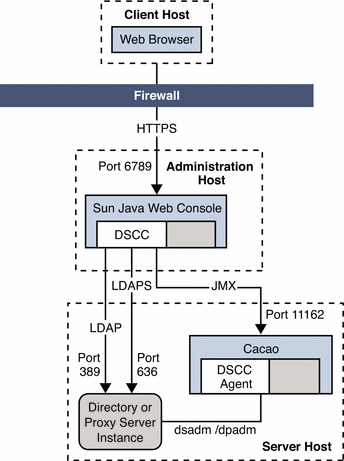Comparison of Single System And Distributed Installation
This section compares and contrasts single host system installations with installations that involve multiple systems.
-
The choice whether to install DSCC and configuration management tools on the same host as the servers that you manage. Alternatively, you can install the tools on a different host from the servers that you manage remotely.
-
The choice whether to create multiple server instances on the same host, or create each server instance on a different host.
This section explains the outcomes of two basic choices about your installation.
Where You Install Directory Service Control Center
Installing DSCC on the same host as the servers that you manage provides a quick and simple solution for evaluation and development. This solution is not recommended for production installations where you rely on redundant systems and on server replica to provide high availability.
When you install DSCC you also install Directory Server software. DSCC uses its own private instance of Directory Server to store configuration information. If you also install the local agent for Directory Server alongside DSCC, you can create Directory Server instances on the system through a web browser to DSCC. You can do so without having to know additional host names and port numbers.
You can install DSCC on a different host from the servers you manage remotely. This solution is recommended for production installations where you rely on redundant systems and on server replica to provide high availability.
Figure 1–2 Administration Host and Server Host on Different Systems

When you install DSCC on the administration host, you must be root. However, you can then use DSCC installed on the administration host to manage server hosts installed as non-root.
For example, you install DSCC on a server or even a suitable workstation outside the data center. You also install server software from the zip distribution on server hosts inside the data center, performing such installations as non-root. Over secure LDAP and JMX, you can then create, configure, and manage all your servers through a web browser to DSCC on the administration host.
Where You Create Server Instances
For production installations, you rely on redundant systems, load balancing, failover capabilities, and server replica to provide high availability. You therefore typically create servers on multiple host systems. Yet, more powerful host systems might each house multiple server instances.
When you create multiple server instances on a single host system, only one server instance can listen on the default ports. As long as you install Directory Server Enterprise Edition software only once, multiple server instances can share the same common agent container.
When you install multiple Directory Server Enterprise Edition versions on a system, each version comes with its own common agent container. Only one of those common agent containers can listen on the default port for JMX management traffic.
- © 2010, Oracle Corporation and/or its affiliates
